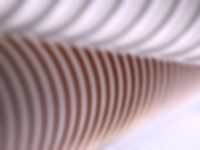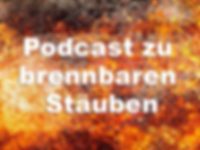These conductive and antistatic hoses meet the special requirements that arise in Ex zones or when transporting flammable bulk materials.
When operating hose assemblies in hazardous areas, ignition hazards can endanger safety. These hazards are usually based on electrostatic charges. Such charging or charge separation can occur when solids or liquids are transported through chargeable hoses. Friction of the conveyed material against the wall and of the conveyed particles among themselves can cause both the conveyed material and the hose surface to become dangerously highly charged. Once released, the ignition energy of such an electrostatic charge can ignite explosive dust-air mixtures.
This is where we come in! Our conductive and permanently antistatic hoses meet the special requirements that arise in Ex zones or when transporting flammable bulk materials. The type of construction as well as the materials used ensure that the hoses mentioned here do not become dangerously charged during operation.
The range of connection solutions specially designed for operation in potentially explosive atmospheres includes extruded hoses and clip hoses alike. In addition, there are individual foil hoses. Work safely and find out now about our permanently antistatic hose solutions.
MaterialsConstruction & Manufacturing
Our permanently antistatic and dissipative hoses offer a wide range of applications and are used in a variety of industries.
Fields of application Contact



The material polyurethane (PU) in our antistatic hoses.
Polyurethane is a versatile plastic with special properties that make it the ideal material for our antistatic hoses. Thermoplastic polyurethanes (TPU), in turn, ideally combine important requirements such as elasticity, resilience and resistance to aging.
All the hoses we manufacture from PU have common material-condition properties: permanent antistatic properties and discharge capability due to a particularly high abrasion resistance.

PTFE in multilayer conductive and antistatic clip hoses
The material PTFE is characterized by an excellent and broad chemical resistance and further by the fact that it is harmless to health.
Some of our multilayer clip hoses are equipped with an inner layer made of an electrically conductive PTFE film.
Since this wall material is anti-adhesive or non-adherent, these hoses offer optimal conditions for the transport of different media.

The material polyethylene (PE) in our antistatic hoses.
Polyethylene is very durable due to its high resistance to acids, alkalis and chemicals and, above all, has a significantly higher chemical resistance than PU.
Our hoses made of PE are particularly suitable for demanding applications, e.g. for transporting aggressive gaseous and liquid media or for transporting fine-grained particles such as dusts and powders. Here, our antistatic hoses prevent electrical charging due to their design.

Profile extrusion: the flexible manufacturing process for light to (very) heavy antistatic hoses.
Extrusion is a flexible manufacturing process for light to (very) heavy hoses in which plastics or other viscous materials to be cured are pressed through a die in a continuous process.
Flow profiles in the design
Due to their smooth inner wall, extruded antistatic hoses offer optimum flow conditions with only minimal flow losses. As soon as solids are transported in a hose, they are usually irregularly shaped particles or particles with specific shapes such as fibers, granulates or salts. When such particles collide with other particles or with the hose wall itself, not only the inside of the hose is subjected to particular stress, but also the conveyed material itself. To avoid negative effects on the transported material, it pays to have an optimum hose profile. This is the only way to ensure less abrasion and thus less material loss during transport.

Most of the products within this group meet the requirements of TRGS 727 or the ATEX standard. The technical rule for hazardous substances TRGS 727 reflects the current safety status for the prevention of ignition hazards due to electrostatic charges and the assessment of an ignition hazard of bulk materials.
It considers in detail electrostatic charges when handling liquids (§ 4 ff), gases (§ 5 ff) and bulk materials (§ 6 ff). In addition, the TRGS also provides information on which hoses may be used when handling the individual media. TRGS 727 distinguishes between aspiration (vacuum transport) and pneumatic transport (pressure transport) of bulk materials.
You should take care to prevent electrostatic charges from the outset. For use in potentially explosive atmospheres, you should use our conductive hose types. However, these hoses must be grounded via the metal-containing support spiral. Please read our operating instructions for this.
Further topics about permanent antistatic and dissipative hoses

Background knowledge: Dust Explosion
In the production facilities for powdery media, such as starch, devastating accidents in the form of explosions can occur due to unintentional electrostatic discharges. Our "EL" type food hoses are ideally suited to minimize the dangers of dust explosions - for example in grain mills.
We have written a whitepaper on the subject of "Dust Explosions".





















